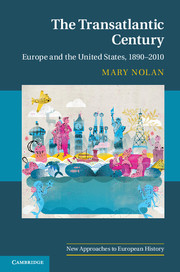Book contents
- Frontmatter
- Contents
- Illustrations
- Maps
- Tables
- Acknowledgments
- Introduction
- 1 An uncertain balance, 1890–1914
- 2 World War I: European crisis and American opportunity
- 3 Ambivalent engagement
- 4 The depression and transatlantic new deals
- 5 Strange affinities, new enemies
- 6 From world war to Cold War
- 7 Cooperation, competition, containment
- 8 Culture wars
- 9 The American Century erodes, 1968–1979
- 10 Renewed conflict and surprising collapse
- 11 A widening Atlantic
- 12 Imperial America, estranged Europe
- Suggested readings
- Index
- References
11 - A widening Atlantic
Published online by Cambridge University Press: 05 November 2012
- Frontmatter
- Contents
- Illustrations
- Maps
- Tables
- Acknowledgments
- Introduction
- 1 An uncertain balance, 1890–1914
- 2 World War I: European crisis and American opportunity
- 3 Ambivalent engagement
- 4 The depression and transatlantic new deals
- 5 Strange affinities, new enemies
- 6 From world war to Cold War
- 7 Cooperation, competition, containment
- 8 Culture wars
- 9 The American Century erodes, 1968–1979
- 10 Renewed conflict and surprising collapse
- 11 A widening Atlantic
- 12 Imperial America, estranged Europe
- Suggested readings
- Index
- References
Summary
The year 1990 marked the beginning not only of a new decade but also of a new post-Cold War order. Perhaps it marked “the end of history,” in Francis Fukuyama’s oft-quoted phrase, for the great ideological battles of the twentieth century among fascism, communism, and democracy were over, and liberalism appeared to have triumphed. Capitalism reigned globally, social democracy was on the defensive, and across the globe right-wing political and economic ideas were gaining adherents. The “evil empire” had collapsed, the United States was militarily unchallenged, and no enemies were in sight to disturb the new pax Americana. After a decade of troubles, the American economy had rebounded, while its European and Japanese counterparts languished. Europe, all of Europe, seemed ripe for full incorporation into an American-dominated global order.
The ensuing two decades, however, were less a story of convergence and cooperation between Europe and the United States than of divergence, disagreement, and at times overt hostility. Economically, politically, and culturally a multipolar global order replaced the bipolar one; only in military terms did the United States continue to reign supreme and alone. Unlike in the late nineteenth and early twentieth centuries, however, the powerful poles are no longer located only in the North Atlantic region. Globalization, measured in the movement of commodities, capital, people, ideas, and cultural products, has returned to levels not seen since before World War I, but the United States and Western Europe are no longer at the center of all exchanges and networks. Manufacturing and finance are dispersed around the globe, and the rise of China is but the most visible symbol of shifting power relations. The United States is once again a nation among nations, even if has great difficulty acknowledging and accepting its diminished role.
- Type
- Chapter
- Information
- The Transatlantic CenturyEurope and America, 1890–2010, pp. 331 - 355Publisher: Cambridge University PressPrint publication year: 2012

